
Blog (864)
Charcot Foot Is a Rare but Serious Foot Condition
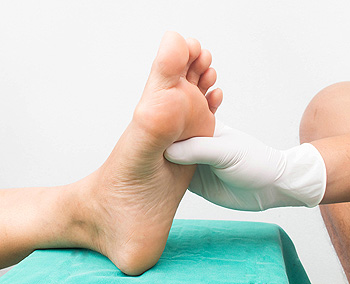 Charcot foot affects the bones, joints, and soft tissues of the foot and ankle. It occurs most commonly in individuals with peripheral neuropathy, particularly those with diabetes. The disease is characterized by the weakening of the bones in the foot, which can fracture easily, leading to deformities. In Charcot foot, the bones weaken and can break with minimal or no apparent trauma. As the condition progresses, the foot can become misshapen and unstable, often resulting in a rocker-bottom deformity. This can severely impair walking and lead to complications if not treated promptly. Symptoms of Charcot foot include swelling, redness, warmth in the affected area, and sometimes pain, though this may be diminished due to neuropathy. The foot may appear deformed, and patients might notice that their shoes no longer fit properly. Diagnosis of Charcot foot generally involves a thorough medical history review, physical examination, and imaging studies such as X-rays or MRI scans to assess bone damage and changes in foot structure. Treatment focuses on stabilizing the foot and preventing further damage. If you suspect you have Charcot foot or are experiencing symptoms, it is suggested that you visit a podiatrist promptly for a comprehensive evaluation and appropriate treatment solutions.
Charcot foot affects the bones, joints, and soft tissues of the foot and ankle. It occurs most commonly in individuals with peripheral neuropathy, particularly those with diabetes. The disease is characterized by the weakening of the bones in the foot, which can fracture easily, leading to deformities. In Charcot foot, the bones weaken and can break with minimal or no apparent trauma. As the condition progresses, the foot can become misshapen and unstable, often resulting in a rocker-bottom deformity. This can severely impair walking and lead to complications if not treated promptly. Symptoms of Charcot foot include swelling, redness, warmth in the affected area, and sometimes pain, though this may be diminished due to neuropathy. The foot may appear deformed, and patients might notice that their shoes no longer fit properly. Diagnosis of Charcot foot generally involves a thorough medical history review, physical examination, and imaging studies such as X-rays or MRI scans to assess bone damage and changes in foot structure. Treatment focuses on stabilizing the foot and preventing further damage. If you suspect you have Charcot foot or are experiencing symptoms, it is suggested that you visit a podiatrist promptly for a comprehensive evaluation and appropriate treatment solutions.
Some foot conditions may require additional professional care. If you have any concerns, contact one of our podiatrists of Westland Foot & Ankle Specialists, P.C.. Our doctors can provide the care you need to keep you pain-free and on your feet.
Rare Foot Conditions
The majority of foot conditions are common and can be treated by a podiatrist. Standard diagnostic procedures are generally used to identify specific conditions and treatment can be rendered. A podiatrist also treats rare foot conditions which can be difficult to diagnose and may need extra attention and care.
There are many rare foot conditions that can affect children. Some of these can include:
- Freiberg’s disease
- Kohler’s disease
- Maffucci syndrome
Freiberg’s disease - This can be seen as a deterioration and flattening of a metatarsal bone that exists in the ball of the foot. It typically affects pre-teen and teenage girls, but can affect anyone at any age. Symptoms that can accompany this can be swelling, stiffness, and the patient may limp.
Kohler’s disease - This often targets the bone in the arch of the foot and affects younger boys. It can lead to an interruption of the blood supply which ultimately can lead to bone deterioration. The patient may limp or experience tenderness, swelling, and redness.
Maffucci syndrome - This affects the long bones in a child’s foot leading to the development of abnormal bone lesions. They are benign growths and typically develop in early childhood and the bones may be susceptible to breaking.
A podiatrist can properly diagnose and treat all types of rare foot conditions. If your child is affected by any of these symptoms or conditions, please don’t hesitate to call our office so the correct treatment method can begin.
If you have any questions please feel free to contact our office located in Westland, MI. . We offer the newest diagnostic tools and technology to treat your foot and ankle needs.
Causes of Foot Pain

Foot pain is a common ailment that can stem from a variety of causes, significantly impacting mobility and quality of life. Injuries such as sprains, fractures, and tendonitis are frequent culprits. Various forms of arthritis, including osteoarthritis, rheumatoid arthritis, and gout, can also lead to foot pain due to joint inflammation and damage. Wearing ill-fitting footwear often increases foot discomfort, leading to issues like bunions, which are painful enlargements of the joint at the base of the big toe. Symptoms of foot pain can include a sharp or dull ache, swelling, stiffness, and a reduced range of motion. Typical treatment strategies include rest, and sometimes more targeted therapies like custom orthotic devices. If you have foot pain that persists or is worsening, it is suggested that you schedule an appointment with a podiatrist who can provide a comprehensive assessment and tailored treatment options to alleviate pain and prevent further complications.
Foot Pain
Foot pain can be extremely painful and debilitating. If you have a foot pain, consult with one of our podiatrists from Westland Foot & Ankle Specialists, P.C.. Our doctors will assess your condition and provide you with quality foot and ankle treatment.
Causes
Foot pain is a very broad condition that could be caused by one or more ailments. The most common include:
- Bunions
- Hammertoes
- Plantar Fasciitis
- Bone Spurs
- Corns
- Tarsal Tunnel Syndrome
- Ingrown Toenails
- Arthritis (such as Gout, Rheumatoid, and Osteoarthritis)
- Flat Feet
- Injury (from stress fractures, broken toe, foot, ankle, Achilles tendon ruptures, and sprains)
- And more
Diagnosis
To figure out the cause of foot pain, podiatrists utilize several different methods. This can range from simple visual inspections and sensation tests to X-rays and MRI scans. Prior medical history, family medical history, and any recent physical traumatic events will all be taken into consideration for a proper diagnosis.
Treatment
Treatment depends upon the cause of the foot pain. Whether it is resting, staying off the foot, or having surgery; podiatrists have a number of treatment options available for foot pain.
If you have any questions, please feel free to contact our office located in Westland, MI. . We offer the newest diagnostic and treatment technologies for all your foot care needs.
Do Your Child's Feet Hurt?
Is It Foot Fungus or Psoriasis?
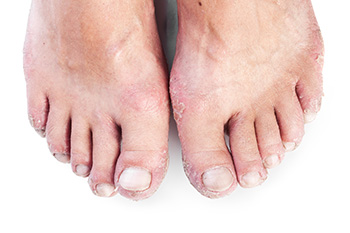
Deciphering whether you have an athlete’s foot infection or psoriasis on the feet can be difficult. Understanding the symptoms can help. Athlete’s foot, a contagious fungal infection thriving in warm, moist environments, typically appears as red, scaly patches between toes or under nails. It may cause itching and discomfort if untreated. On the other hand, psoriasis, an autoimmune disorder, manifests with similar symptoms but is not contagious. Psoriasis lesions may cause silvery scales and vary in color over time. They often involve the soles and nails, causing soreness or tenderness. Nail changes, like pitting or discoloration, are common in psoriasis. While athlete’s foot primarily itches, psoriasis can lead to joint stiffness in addition to discomfort. Treatment approaches also differ. Athlete's foot is usually treated with antifungal medications, while psoriasis management may involve topical treatments, light therapy, or systemic medications. If you have a type of rash on your feet, it is suggested that you schedule an appointment with a podiatrist for a proper diagnosis and appropriate treatment.
Everyday foot care is very important to prevent infection and other foot ailments. If you need your feet checked, contact one of our podiatrists from Westland Foot & Ankle Specialists, P.C.. Our doctors can provide the care you need to keep you pain-free and on your feet.
Everyday Foot Care
Often, people take care of their bodies, face and hair more so than they do for their feet. But the feet are a very important aspect of our bodies, and one that we should pay more attention to. Without our feet, we would not be able to perform most daily tasks.
It is best to check your feet regularly to make sure there are no new bruises or cuts that you may not have noticed before. For dry feet, moisturizer can easily be a remedy and can be applied as often as necessary to the affected areas. Wearing shoes that fit well can also help you maintain good foot health, as well as making it easier to walk and do daily activities without the stress or pain of ill-fitting shoes, high heels, or even flip flops. Wearing clean socks with closed shoes is important to ensure that sweat and bacteria do not accumulate within the shoe. Clean socks help to prevent Athlete’s foot, fungi problems, bad odors, and can absorb sweat.
If you have any questions please feel free to contact our office located in Westland, MI. . We offer the newest diagnostic and treatment technologies for all your foot and ankle needs.
Common Achilles Tendon Injuries
 The Achilles tendon connects the calf muscles to the heel bone. This tendon is susceptible to different kinds of injuries that can affect mobility and cause pain. Common injuries include Achilles tendonitis, Achilles bursitis, and Achilles tendon rupture. Achilles tendonitis is where repetitive stress and overuse lead to inflammation of the tendon, which causes pain and swelling near the heel. Achilles bursitis involves inflammation of the bursa, a small fluid-filled sac located near the heel bone. This condition causes similar symptoms to tendonitis but occurs at the back of the heel. An Achilles tendon rupture is more severe and involves a partial or complete tear of the tendon, often accompanied by sudden, sharp pain and an inability to walk properly. Treatment varies depending on the severity of the injury but may include rest, targeted stretching exercises, and in severe cases of rupture, surgical intervention. Regular visits to a podiatrist are important for proper diagnosis, management of symptoms, and guidance on rehabilitation to ensure effective recovery. If you have an injured Achilles tendon, it is suggested that you make an appointment with a podiatrist today.
The Achilles tendon connects the calf muscles to the heel bone. This tendon is susceptible to different kinds of injuries that can affect mobility and cause pain. Common injuries include Achilles tendonitis, Achilles bursitis, and Achilles tendon rupture. Achilles tendonitis is where repetitive stress and overuse lead to inflammation of the tendon, which causes pain and swelling near the heel. Achilles bursitis involves inflammation of the bursa, a small fluid-filled sac located near the heel bone. This condition causes similar symptoms to tendonitis but occurs at the back of the heel. An Achilles tendon rupture is more severe and involves a partial or complete tear of the tendon, often accompanied by sudden, sharp pain and an inability to walk properly. Treatment varies depending on the severity of the injury but may include rest, targeted stretching exercises, and in severe cases of rupture, surgical intervention. Regular visits to a podiatrist are important for proper diagnosis, management of symptoms, and guidance on rehabilitation to ensure effective recovery. If you have an injured Achilles tendon, it is suggested that you make an appointment with a podiatrist today.
Achilles tendon injuries need immediate attention to avoid future complications. If you have any concerns, contact one of our podiatrists of Westland Foot & Ankle Specialists, P.C.. Our doctors can provide the care you need to keep you pain-free and on your feet.
What Is the Achilles Tendon?
The Achilles tendon is a tendon that connects the lower leg muscles and calf to the heel of the foot. It is the strongest tendon in the human body and is essential for making movement possible. Because this tendon is such an integral part of the body, any injuries to it can create immense difficulties and should immediately be presented to a doctor.
What Are the Symptoms of an Achilles Tendon Injury?
There are various types of injuries that can affect the Achilles tendon. The two most common injuries are Achilles tendinitis and ruptures of the tendon.
Achilles Tendinitis Symptoms
- Inflammation
- Dull to severe pain
- Increased blood flow to the tendon
- Thickening of the tendon
Rupture Symptoms
- Extreme pain and swelling in the foot
- Total immobility
Treatment and Prevention
Achilles tendon injuries are diagnosed by a thorough physical evaluation, which can include an MRI. Treatment involves rest, physical therapy, and in some cases, surgery. However, various preventative measures can be taken to avoid these injuries, such as:
- Thorough stretching of the tendon before and after exercise
- Strengthening exercises like calf raises, squats, leg curls, leg extensions, leg raises, lunges, and leg presses
If you have any questions please feel free to contact our office located in Westland, MI. . We offer the newest diagnostic tools and technology to treat your foot and ankle needs.
Causes of Toenail Fungus
 Toenail fungus, also known as onychomycosis, is primarily caused by a type of fungi called dermatophytes. The fungi thrive in warm, moist environments. Common sites of infection include public pools, showers, and locker rooms, where the fungus easily spreads from one person to another through direct contact with contaminated surfaces. The risk of developing toenail fungus increases with various factors, such as wearing tight, non-breathable shoes that trap moisture, having a minor nail or skin injury around the nail, or having a weakened immune system. Low blood circulation and slow nail growth can make people susceptible to contracting toenail fungus. Keeping the feet clean and dry, wearing breathable footwear, and using antifungal sprays or powders in shoes and socks can help reduce the chances of contracting toenail fungus. If you are suffering from toenail fungus, it is suggested that you make an appointment with a podiatrist today.
Toenail fungus, also known as onychomycosis, is primarily caused by a type of fungi called dermatophytes. The fungi thrive in warm, moist environments. Common sites of infection include public pools, showers, and locker rooms, where the fungus easily spreads from one person to another through direct contact with contaminated surfaces. The risk of developing toenail fungus increases with various factors, such as wearing tight, non-breathable shoes that trap moisture, having a minor nail or skin injury around the nail, or having a weakened immune system. Low blood circulation and slow nail growth can make people susceptible to contracting toenail fungus. Keeping the feet clean and dry, wearing breathable footwear, and using antifungal sprays or powders in shoes and socks can help reduce the chances of contracting toenail fungus. If you are suffering from toenail fungus, it is suggested that you make an appointment with a podiatrist today.
For more information about treatment, contact one of our podiatrists of Westland Foot & Ankle Specialists, P.C.. Our doctors can provide the care you need to keep you pain-free and on your feet.
Toenail Fungus Treatment
Toenail fungus is a condition that affects many people and can be especially hard to get rid of. Fortunately, there are several methods to go about treating and avoiding it.
Antifungals & Deterrence
Oral antifungal medicine has been shown to be effective in many cases. It is important to consult with a podiatrist to determine the proper regiment for you, or potentially explore other options.
Applying foot powder on the feet and shoes helps keep the feet free of moisture and sweat.
Sandals or open toed shoes – Wearing these will allow air movement and help keep feet dry. They also expose your feet to light, which fungus cannot tolerate. Socks with moisture wicking material also help as well.
If you have any questions please feel free to contact our office located in Westland, MI. . We offer the newest diagnostic tools and technology to treat your foot and ankle needs.
Wounds That Don't Heal Need to Be Checked
Avoiding Diabetic Foot Ulcers
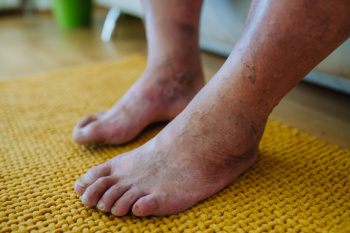 Monitoring foot health is important for people with diabetes, as they are at a higher risk of developing foot ulcers due to reduced blood flow and nerve sensitivity in their feet. Daily foot inspections to check for cuts, blisters, or any unusual changes is an important prevention measure. It is also important to maintain good foot hygiene and wear well-fitted shoes that minimize pressure points. Regularly moisturize the feet, except between the toes, to help prevent dry skin and cracks that could potentially become infected. A foot doctor, or podiatrist, plays a key role in this preventative care. Podiatrists can conduct thorough foot exams during routine check-ups, provide professional nail care, and offer advice on appropriate footwear. They can also custom-fit diabetic shoes and prescribe orthotics to ensure even weight distribution, which reduces the risk of skin breakdown. Additionally, a podiatrist can help manage any corns, calluses, or minor wounds before they develop into serious complications. If you have diabetes and at a higher risk for developing foot ulcers, it is suggested that you add a podiatrist to your care team.
Monitoring foot health is important for people with diabetes, as they are at a higher risk of developing foot ulcers due to reduced blood flow and nerve sensitivity in their feet. Daily foot inspections to check for cuts, blisters, or any unusual changes is an important prevention measure. It is also important to maintain good foot hygiene and wear well-fitted shoes that minimize pressure points. Regularly moisturize the feet, except between the toes, to help prevent dry skin and cracks that could potentially become infected. A foot doctor, or podiatrist, plays a key role in this preventative care. Podiatrists can conduct thorough foot exams during routine check-ups, provide professional nail care, and offer advice on appropriate footwear. They can also custom-fit diabetic shoes and prescribe orthotics to ensure even weight distribution, which reduces the risk of skin breakdown. Additionally, a podiatrist can help manage any corns, calluses, or minor wounds before they develop into serious complications. If you have diabetes and at a higher risk for developing foot ulcers, it is suggested that you add a podiatrist to your care team.
Diabetic foot care is important in preventing foot ailments such as ulcers. If you are suffering from diabetes or have any other concerns about your feet, contact one of our podiatrists from Westland Foot & Ankle Specialists, P.C.. Our doctors can provide the care you need to keep you pain-free and on your feet.
Diabetic Foot Care
Diabetes affects millions of people every year. The condition can damage blood vessels in many parts of the body, especially the feet. Because of this, taking care of your feet is essential if you have diabetes, and having a podiatrist help monitor your foot health is highly recommended.
The Importance of Caring for Your Feet
- Routinely inspect your feet for bruises or sores.
- Wear socks that fit your feet comfortably.
- Wear comfortable shoes that provide adequate support.
Patients with diabetes should have their doctor monitor their blood levels, as blood sugar levels play such a huge role in diabetic care. Monitoring these levels on a regular basis is highly advised.
It is always best to inform your healthcare professional of any concerns you may have regarding your feet, especially for diabetic patients. Early treatment and routine foot examinations are keys to maintaining proper health, especially because severe complications can arise if proper treatment is not applied.
If you have any questions please feel free to contact our office located in Westland, MI. . We offer the newest diagnostic and treatment technologies for all your foot and ankle needs.
Causes of Cracked Heels
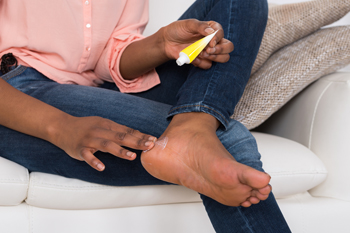 Cracked and dry heels can be a bothersome and sometimes painful issue that many people face. There are several common causes behind this condition, including dry skin, lack of moisture, or standing for long periods. Wearing open-back shoes and specific medical conditions, such as diabetes or thyroid disease, can also contribute. People who have atopic dermatitis, psoriasis, and other skin issues may have a higher likelihood of developing cracked heels. When the skin on the heels becomes excessively dry, it loses its elasticity and may crack under pressure, leading to discomfort and potential complications if left untreated. Additionally, certain lifestyle factors, like inadequate hydration or poor foot care practices, can make the problem worse. Podiatrists, or foot doctors, can offer treatments, such as moisturizing creams, exfoliation, or custom orthotics, to provide relief and promote healing. If you are struggling with cracked or dry heels, it is suggested that you consult a podiatrist for help.
Cracked and dry heels can be a bothersome and sometimes painful issue that many people face. There are several common causes behind this condition, including dry skin, lack of moisture, or standing for long periods. Wearing open-back shoes and specific medical conditions, such as diabetes or thyroid disease, can also contribute. People who have atopic dermatitis, psoriasis, and other skin issues may have a higher likelihood of developing cracked heels. When the skin on the heels becomes excessively dry, it loses its elasticity and may crack under pressure, leading to discomfort and potential complications if left untreated. Additionally, certain lifestyle factors, like inadequate hydration or poor foot care practices, can make the problem worse. Podiatrists, or foot doctors, can offer treatments, such as moisturizing creams, exfoliation, or custom orthotics, to provide relief and promote healing. If you are struggling with cracked or dry heels, it is suggested that you consult a podiatrist for help.
If the skin on your feet starts to crack, you may want to see a podiatrist to find treatment. If you have any concerns, contact one of our podiatrists from Westland Foot & Ankle Specialists, P.C.. Our doctors can provide the care you need to keep you pain-free and on your feet.
Cracked Heels
It is important to moisturize your cracked heels in order to prevent pain, bleeding, and infection. The reason cracked heels form is because the skin on the foot is too dry to support the immense pressure placed on them. When the foot expands, the dry skin on the foot begins to split.
Ways to Help Heal Them
- Invest in a good foot cream
- Try Using Petroleum Jelly
- Ease up on Soaps
- Drink Plenty of Water
Ways to Prevent Cracked Heels
- Moisturize After Showering
- Skip a Shower
- Keep Shower Water Lukewarm
- Don’t Scrub Your Feet
If you are unsure how to proceed in treating cracked heels, seek guidance from a podiatrist. Your doctor will help you with any questions or information you may need.
If you have any questions, please feel free to contact our office located in Westland, MI. . We offer the newest diagnostic and treatment technologies for all your foot care needs.
Foot Injuries From Rock Climbing

Rock climbing, an exhilarating sport enjoyed by many, can also pose risks of foot injuries, both acute and chronic. Acute injuries often occur due to sudden trauma or overuse during climbs. Common acute foot injuries include sprains, strains, fractures, and abrasions, often resulting from slips, falls, or improper foot placements. Climbing shoes, designed for precision and grip, can exacerbate foot issues if they fit too tightly or lack proper support. Wearing ill-fitting shoes may lead to blisters, corns, or ingrown toenails, while prolonged use can contribute to conditions like plantar fasciitis or tendonitis. If you participate in rock climbing and have sustained a foot injury, it is suggested that you schedule an appointment with a podiatrist for diagnosis and treatment. These healthcare professionals can also provide guidance on proper shoe fit, and recommend supportive inserts, and custom-made orthotics.
Ankle and foot injuries are common among athletes and in many sports. They can be caused by several problems and may be potentially serious. If you are feeling pain or think you were injured in a sporting event or when exercising, consult with one of our podiatrists from Westland Foot & Ankle Specialists, P.C.. Our doctors will assess your condition and provide you with quality foot and ankle treatment.
Common Injuries
The most common injuries that occur in sporting activities include:
- Achilles Tendonitis
- Achilles Tendon Rupture
- Ankle Sprains
- Broken Foot
- Plantar Fasciitis
- Stress Fractures
- Turf Toe
Symptoms
Symptoms vary depending upon the injury and in some cases, there may be no symptoms at all. However, in most cases, some form of symptom is experienced. Pain, aching, burning, bruising, tenderness, tightness or stiffness, sensation loss, difficulty moving, and swelling are the most common symptoms.
Treatment
Just as symptoms vary depending upon the injury, so do treatment options. A common treatment method is known as the RICE method. This method involves rest, applying ice, compression and elevating the afflicted foot or ankle. If the injury appears to be more serious, surgery might be required, such as arthroscopic or reconstructive surgery. Lastly, rehabilitation or therapy might be needed to gain full functionality in the afflicted area. Any discomfort experienced by an athlete must be evaluated by a licensed, reputable medical professional.
If you have any questions, please feel free to contact our office located in Westland, MI. . We offer the newest diagnostic and treatment technologies for all your foot care needs.
More...
It's Time for Beautiful Feet
Types of Hammertoe Treatments
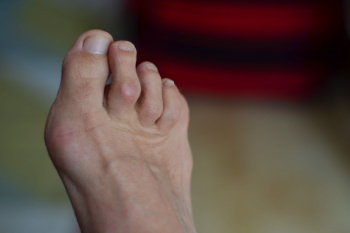 Treatment for hammertoe, a condition where the toe bends abnormally, varies depending on the severity of the condition. Treatment can range from non-invasive approaches to surgical intervention. Initially, a podiatrist may recommend conservative methods, such as wearing roomier, more comfortable shoes to accommodate the deformity and using custom orthotic devices to relieve pain. Stretching exercises may also be recommended to strengthen toe muscles and improve flexibility. For more persistent cases, where the toe becomes rigid or pain is severe, surgical options may be considered. Surgery aims to straighten the toe, and this may involve removing a portion of the bone or realigning the tendons and ligaments. Post-surgery, patients often go through some rehabilitation to restore function and mobility. Consulting with a podiatrist about hammertoe is suggested to determine the most appropriate treatment plan for your specific needs.
Treatment for hammertoe, a condition where the toe bends abnormally, varies depending on the severity of the condition. Treatment can range from non-invasive approaches to surgical intervention. Initially, a podiatrist may recommend conservative methods, such as wearing roomier, more comfortable shoes to accommodate the deformity and using custom orthotic devices to relieve pain. Stretching exercises may also be recommended to strengthen toe muscles and improve flexibility. For more persistent cases, where the toe becomes rigid or pain is severe, surgical options may be considered. Surgery aims to straighten the toe, and this may involve removing a portion of the bone or realigning the tendons and ligaments. Post-surgery, patients often go through some rehabilitation to restore function and mobility. Consulting with a podiatrist about hammertoe is suggested to determine the most appropriate treatment plan for your specific needs.
Hammertoe
Hammertoes can be a painful condition to live with. For more information, contact one of our podiatrists from Westland Foot & Ankle Specialists, P.C.. Our doctors will answer any of your foot- and ankle-related questions.
Hammertoe is a foot deformity that affects the joints of the second, third, fourth, or fifth toes of your feet. It is a painful foot condition in which these toes curl and arch up, which can often lead to pain when wearing footwear.
Symptoms
- Pain in the affected toes
- Development of corns or calluses due to friction
- Inflammation
- Redness
- Contracture of the toes
Causes
Genetics – People who are genetically predisposed to hammertoe are often more susceptible
Arthritis – Because arthritis affects the joints in your toes, further deformities stemming from arthritis can occur
Trauma – Direct trauma to the toes could potentially lead to hammertoe
Ill-fitting shoes – Undue pressure on the front of the toes from ill-fitting shoes can potentially lead to the development of hammertoe
Treatment
Orthotics – Custom made inserts can be used to help relieve pressure placed on the toes and therefore relieve some of the pain associated with it
Medications – Oral medications such as anti-inflammatories or NSAIDs could be used to treat the pain and inflammation hammertoes causes. Injections of corticosteroids are also sometimes used
Surgery – In more severe cases where the hammertoes have become more rigid, foot surgery is a potential option
If you have any questions please contact our office located in Westland, MI. . We offer the newest diagnostic and treatment technologies for all your foot and ankle needs.
What Are Plantar Warts?
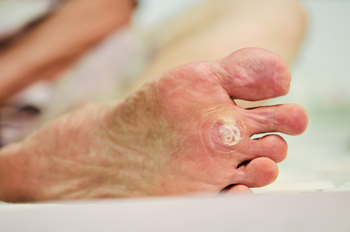 Plantar warts are non-cancerous skin growths that appear on the soles of the feet and are caused by the human papillomavirus, or HPV. These warts often look like small, rough lesions on the foot's surface, sometimes with a cauliflower-like texture. Unlike other types of warts, plantar warts grow inward due to the pressure of walking and standing, which can also cause a hard layer of skin, or callus, to form over them. They may have one or more black dots in the center, which are tiny blood vessels. Plantar warts can be painful, feeling like a lump under your foot when you stand or walk. While they can resolve on their own, treatment for plantar warts might be necessary if they cause discomfort or spread. If you have plantar warts, it is suggested that you schedule an appointment with a podiatrist who can offer effective treatment options.
Plantar warts are non-cancerous skin growths that appear on the soles of the feet and are caused by the human papillomavirus, or HPV. These warts often look like small, rough lesions on the foot's surface, sometimes with a cauliflower-like texture. Unlike other types of warts, plantar warts grow inward due to the pressure of walking and standing, which can also cause a hard layer of skin, or callus, to form over them. They may have one or more black dots in the center, which are tiny blood vessels. Plantar warts can be painful, feeling like a lump under your foot when you stand or walk. While they can resolve on their own, treatment for plantar warts might be necessary if they cause discomfort or spread. If you have plantar warts, it is suggested that you schedule an appointment with a podiatrist who can offer effective treatment options.
Plantar warts can be very uncomfortable. If you need your feet checked, contact one of our podiatrists from Westland Foot & Ankle Specialists, P.C.. Our doctors will assist you with all of your foot and ankle needs.
About Plantar Warts
Plantar warts are the result of HPV, or human papillomavirus, getting into open wounds on the feet. They are mostly found on the heels or balls of the feet.
While plantar warts are generally harmless, those experiencing excessive pain or those suffering from diabetes or a compromised immune system require immediate medical care. Plantar warts are easily diagnosed, usually through scraping off a bit of rough skin or by getting a biopsy.
Symptoms
- Lesions on the bottom of your feet, usually rough and grainy
- Hard or thick callused spots
- Wart seeds, which are small clotted blood vessels that look like little black spots
- Pain, discomfort, or tenderness of your feet when walking or standing
Treatment
- Freezing
- Electric tool removal
- Laser Treatment
- Topical Creams (prescription only)
- Over-the-counter medications
To help prevent developing plantar warts, avoid walking barefoot over abrasive surfaces that can cause cuts or wounds for HPV to get into. Avoiding direct contact with other warts, as well as not picking or rubbing existing warts, can help prevent the further spread of plantar warts. However, if you think you have developed plantar warts, speak to your podiatrist. He or she can diagnose the warts on your feet and recommend the appropriate treatment options.
If you have any questions please feel free to contact our office located in Westland, MI. . We offer the newest diagnostic and treatment technologies for all your foot and ankle needs.
Types of Acute Ankle Sprains
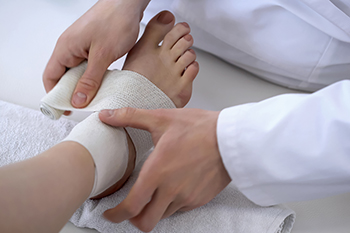
Acute ankle sprains are common injuries when the ligaments surrounding the ankle are stretched or torn. There are three main types of sprains. They are inversion, eversion, and high ankle sprains. Inversion sprains, the most prevalent, happen when the foot rolls inward, stretching the lateral ligaments. Eversion sprains occur when the foot rolls outward, affecting the medial ligaments. High ankle sprains involve the ligaments connecting the tibia and fibula and typically result from excessive external rotation of the foot. These injuries often transpire during activities involving sudden changes in direction, uneven surfaces, or improper landing from jumps. If not adequately treated, acute ankle sprains can lead to chronic ankle instability. This occurs when the ligaments do not heal properly, resulting in recurring episodes of instability, pain, and potential long-term joint damage. Chronic instability may necessitate rehabilitation exercises, bracing, or even surgery to regain stability and prevent further injury. If you have sprained your ankle, and especially if you have had recurrent ankle sprains, it is suggested that you make an appointment with a podiatrist for expert evaluation, diagnosis, and treatment.
Ankle sprains are common but need immediate attention. If you need your feet checked, contact one of our podiatrists from Westland Foot & Ankle Specialists, P.C.. Our doctors can provide the care you need to keep you pain-free and on your feet.
How Does an Ankle Sprain Occur?
Ankle sprains take place when the ligaments in your ankle are torn or stretched beyond their limits. There are multiple ways that the ankle can become injured, including twisting or rolling over onto your ankle, putting undue stress on it, or causing trauma to the ankle itself.
What Are the Symptoms?
- Mild to moderate bruising
- Limited mobility
- Swelling
- Discoloration of the skin (depending on severity)
Preventing a Sprain
- Wearing appropriate shoes for the occasion
- Stretching before exercises and sports
- Knowing your limits
Treatment of a Sprain
Treatment of a sprain depends on the severity. Many times, people are told to rest and remain off their feet completely, while others are given an air cast. If the sprain is very severe, surgery may be required.
If you have suffered an ankle sprain previously, you may want to consider additional support such as a brace and regular exercises to strengthen the ankle.
If you have any questions please feel free to contact our office located in Westland, MI. . We offer the newest diagnostic and treatment technologies for all your foot and ankle needs.



